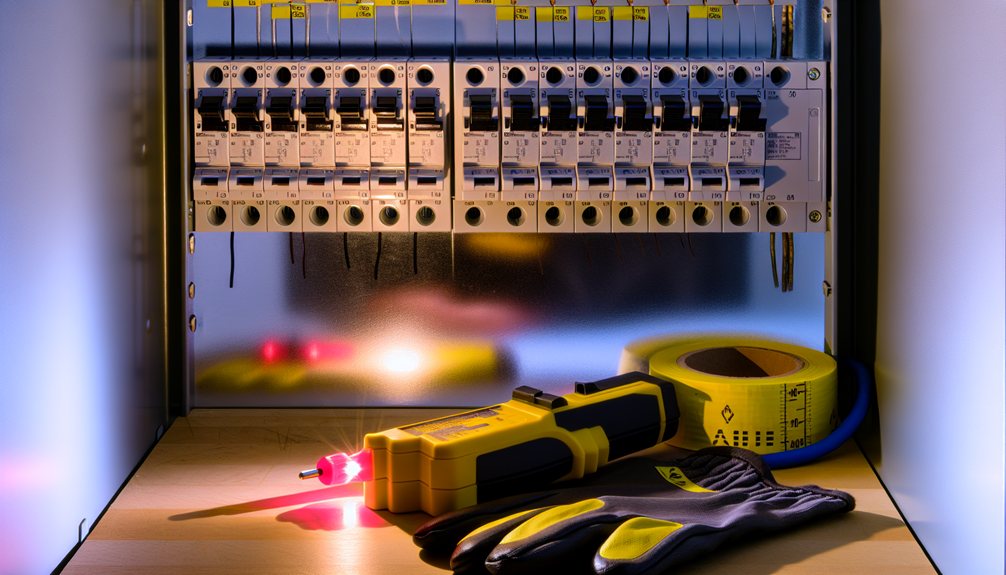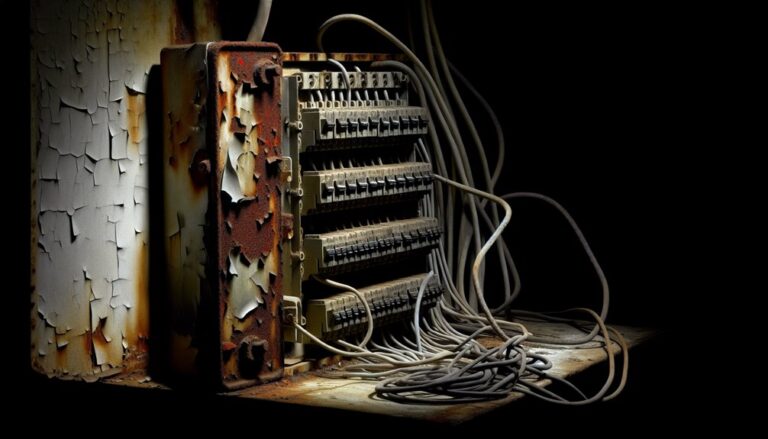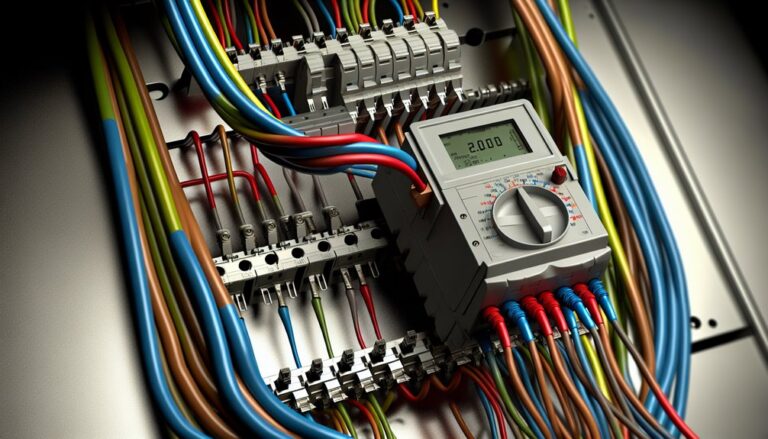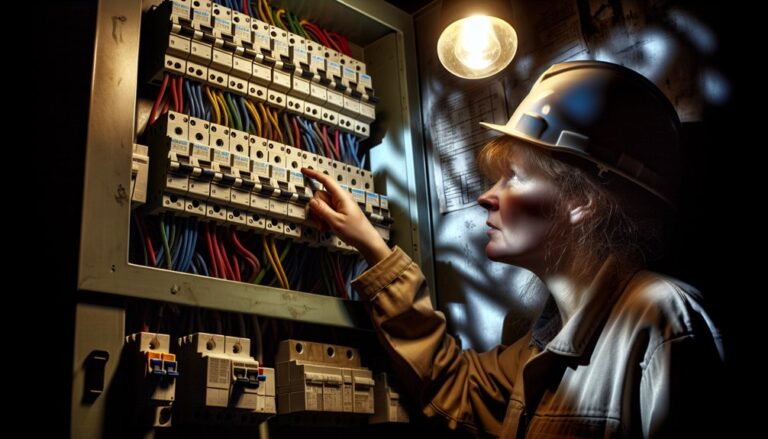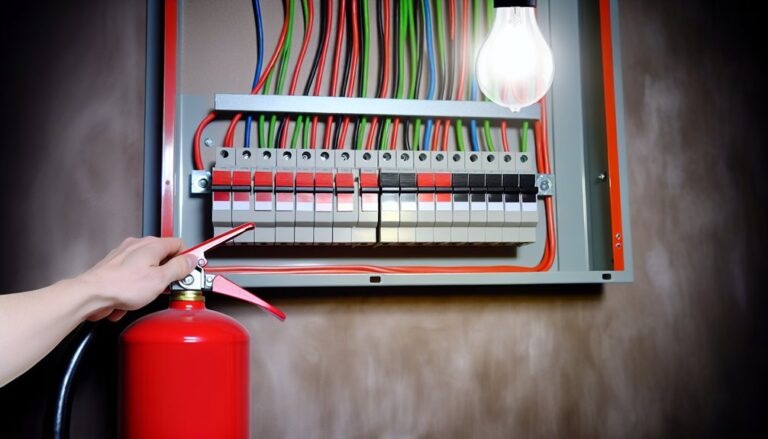Preventing Electrical Hazards
To prevent electrical hazards, guarantee you follow safety guidelines like hiring a professional for installations and conducting regular maintenance checks. Inspect all wiring and outlets for signs of wear or damage, and replace faulty components immediately. Use extension cords safely, avoiding overload, and childproof outlets to protect little ones. Install Ground Fault Circuit Interrupters (GFCIs) in wet areas, and utilize surge protectors for sensitive devices. Discover more essential practices to enhance your electrical safety.
Key Takeaways
- Ensure all electrical installations comply with the National Electrical Code (NEC) and local safety standards to minimize risks.
- Regularly schedule maintenance and inspections to assess wiring integrity, connections, and overall system functionality.
- Recognize warning signs such as flickering lights or unusual sounds to address potential hazards promptly.
- Use extension cords appropriately, inspecting for damage and avoiding overload to prevent electrical fires.
- Seek professional assistance for installations and repairs to guarantee safety and compliance with industry standards.
Understanding Electrical Hazards
Electrical hazards pose significant risks in both residential and industrial settings, as they can lead to serious injuries or even fatalities. Understanding these hazards is essential for your safety.
Current regulations, such as the National Electrical Code (NEC), are designed to mitigate risks associated with electrical systems. They outline safety standards and installation practices to prevent incidents.
Historical incidents, like the Triangle Shirtwaist Factory fire, underscore the consequences of neglecting electrical safety. Learning about the common types of hazards—such as overloaded circuits, faulty wiring, and improper grounding—can help you identify and address potential dangers before they escalate.
Importance of Professional Installation
When you choose to install electrical systems or components, relying on a professional can greatly reduce the risk of hazards.
Professionals are well-versed in local codes compliance, guaranteeing that your installations meet safety standards. This knowledge helps prevent potential issues that could arise from improper wiring or component selection.
Additionally, the installation benefits of hiring an expert include a thorough assessment of your electrical needs, which can lead to more efficient and reliable systems.
Professionals also use specialized tools and techniques that minimize risks during installation, further safeguarding your home.
Regular Maintenance and Inspections
Even with professional installation, regular maintenance and inspections are essential for ensuring the ongoing safety and efficiency of your electrical systems.
Implementing preventive measures not only helps identify potential issues but also prolongs the lifespan of your equipment. Establishing clear inspection schedules allows you to systematically evaluate your systems, ensuring that all components function correctly.
During these inspections, pay close attention to connections, wiring integrity, and circuit functionality. It’s vital to document findings and address any anomalies immediately to prevent future hazards.
Regular maintenance, including cleaning and testing, supports peak performance and compliance with safety standards. By prioritizing these practices, you safeguard your environment against electrical failures and enhance the overall reliability of your systems.
Recognizing Warning Signs
How can you tell if your electrical system is in trouble? Start by paying attention to flickering lights. This often signals overloaded circuits or faulty connections. If you notice lights dimming or brightening unexpectedly, it’s a warning sign that demands immediate attention.
Next, listen for unusual sounds. Buzzing or crackling noises can indicate loose wiring or failing components, which pose serious risks.
Additionally, check for warm or hot outlets and switches; this can suggest overheating, leading to potential fires.
Finally, if you smell burning or plastic odors near electrical devices, don’t ignore it.
These warning signs are essential for preventing electrical hazards, so address any concerns promptly to guarantee your home remains safe and secure.
Safe Use of Extension Cords
While extension cords can provide convenience for powering devices in hard-to-reach areas, using them safely is essential to avoid electrical hazards.
Start by choosing the right extension cord types for your needs—heavy-duty cords are ideal for high-wattage appliances, while lighter cords work for small electronics. Always inspect cords for damage before use and never plug multiple high-demand devices into a single cord.
Practice safe extension practices by keeping cords away from water and heat sources, and avoid running them through doorways or under carpets, which can lead to wear or overheating.
Finally, unplug extension cords when not in use to prevent risks associated with overcurrent or faulty connections. Prioritize safety to guarantee a hazard-free environment.
Childproofing Electrical Outlets
Ensuring your home is safe goes beyond using extension cords properly; childproofing electrical outlets is a critical step in preventing accidents. A simple yet effective method is using outlet covers, which can greatly enhance electrical safety in your home. These covers prevent children from inserting objects into outlets, reducing the risk of electrical shock.
| Type of Outlet Cover | Purpose |
|---|---|
| Plastic Covers | Block access to outlets |
| Sliding Plate Covers | Require adult operation |
| Tamper-Resistant Outlets | Built-in safety features |
| Pop-Up Outlets | Hide when not in use |
Installing Ground Fault Circuit Interrupters (GFCIs)
Installing Ground Fault Circuit Interrupters (GFCIs) is essential for enhancing electrical safety in areas prone to moisture, such as kitchens and bathrooms.
GFCIs monitor electrical currents and disconnect power when they detect imbalances, effectively preventing electrical shocks. The benefits of GFCIs include increased safety for you and your family, as well as compliance with electrical codes.
For GFCI installation, start by turning off the power at the breaker box. Remove the existing outlet and connect the GFCI according to the manufacturer’s instructions, ensuring the line and load wires are properly attached.
After securing the outlet, restore power and test the GFCI using its built-in test button. Regularly check your GFCIs to maintain ideal safety and performance.
Using Surge Protectors
Using surge protectors is critical for safeguarding your electronic devices against voltage spikes caused by power surges.
There are various surge protector types, including point-of-use strips, whole-house systems, and UPS units. Point-of-use strips are ideal for individual devices, while whole-house systems offer thorough protection for your entire electrical system.
When it comes to surge protector placement, make sure you install them as close to the devices you want to protect as possible. This minimizes the distance that a surge must travel, reducing the risk of damage.
Remember to check the joule rating of your surge protector to confirm it can handle the potential surges in your area. Regularly inspect your surge protectors for wear and replace them as needed for maximum protection.
Emergency Preparedness and Response
While power outages and electrical emergencies can happen without warning, having a solid emergency preparedness and response plan can greatly reduce risks and enhance safety. Start by assembling emergency kits containing essential supplies such as flashlights, batteries, first aid items, and non-perishable food. Regular safety drills will guarantee everyone knows their roles during an emergency, which minimizes confusion and panic.
| Emergency Kit Items | Importance |
|---|---|
| Flashlights | Provides light during outages |
| Batteries | Powers essential devices |
| First Aid Supplies | Addresses injuries quickly |
| Non-perishable Food | Sustains during extended outages |
Stay proactive by checking your emergency kits regularly and practicing safety drills to reinforce your plan. This preparation could save lives.
About Us
We understand that electrical issues can be stressful and overwhelming. That’s why we are here to lend a helping hand and provide you with the best electrical services in town. As a team of experienced electricians, we take pride in our ability to solve any electrical problem with precision and care.
Pages
Follow us
© 2025 By Electrician Fort Lauderdale Today

